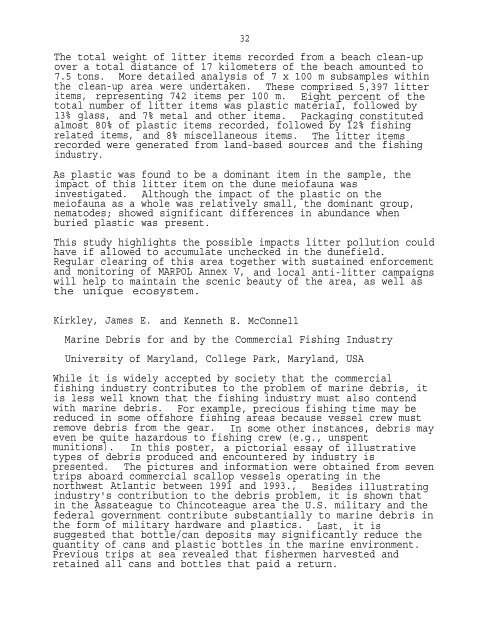Poster abstracts and manuscripts from the Third International ...
Poster abstracts and manuscripts from the Third International ...
Poster abstracts and manuscripts from the Third International ...
Create successful ePaper yourself
Turn your PDF publications into a flip-book with our unique Google optimized e-Paper software.
32<br />
The total weight of litter items recorded <strong>from</strong> a beach clean-up<br />
over a total distance of 17 kilometers of <strong>the</strong> beach amounted to<br />
7.5 tons. More detailed analysis of 7 x 100 m subsamples within<br />
<strong>the</strong> clean-up area were undertaken. These comprised 5,397 litter<br />
items, representing 742 items per 100 m. Eight percent of <strong>the</strong><br />
total number of litter items was plastic material, followed by<br />
13% glass, <strong>and</strong> 7% metal <strong>and</strong> o<strong>the</strong>r items. Packaging constituted<br />
almost 80% of plastic items recorded, followed by 12% fishing<br />
related items, <strong>and</strong> 8% miscellaneous items. The litter items<br />
recorded were generated <strong>from</strong> l<strong>and</strong>-based sources <strong>and</strong> <strong>the</strong> fishing<br />
industry.<br />
As plastic was found to be a dominant item in <strong>the</strong> sample, <strong>the</strong><br />
impact of this litter item on <strong>the</strong> dune meiofauna was<br />
investigated. Although <strong>the</strong> impact of <strong>the</strong> plastic on <strong>the</strong><br />
meiofauna as a whole was relatively small, <strong>the</strong> dominant group,<br />
nematodes; showed significant differences in abundance when<br />
buried plastic was present.<br />
This study highlights <strong>the</strong> possible impacts litter pollution could<br />
have if allowed to accumulate unchecked in <strong>the</strong> dunefield.<br />
Regular clearing of this area toge<strong>the</strong>r with sustained enforcement<br />
<strong>and</strong> monitoring of MARPOL Annex V, <strong>and</strong> local anti-litter campaigns<br />
will help to maintain <strong>the</strong> scenic beauty of <strong>the</strong> area, as well as<br />
<strong>the</strong> unique ecosystem.<br />
Kirkley, James E. <strong>and</strong> Kenneth E. McConnell<br />
Marine Debris for <strong>and</strong> by <strong>the</strong> Commercial Fishing Industry<br />
University of Maryl<strong>and</strong>, College Park, Maryl<strong>and</strong>, USA<br />
While it is widely accepted by society that <strong>the</strong> commercial<br />
fishing industry contributes to <strong>the</strong> problem of marine debris, it<br />
is less well known that <strong>the</strong> fishing industry must also contend<br />
with marine debris. For example, precious fishing time may be<br />
reduced in some offshore fishing areas because vessel crew must<br />
remove debris <strong>from</strong> <strong>the</strong> gear. In some o<strong>the</strong>r instances, debris may<br />
even be quite hazardous to fishing crew (e.g., unspent<br />
munitions). In this poster, a pictorial essay of illustrative<br />
types of debris produced <strong>and</strong> encountered by industry is<br />
presented. The pictures <strong>and</strong> information were obtained <strong>from</strong> seven<br />
trips aboard commercial scallop vessels operating in <strong>the</strong><br />
northwest Atlantic between 1991 <strong>and</strong> 1993., Besides illustrating<br />
industry's contribution to <strong>the</strong> debris problem, it is shown that<br />
in <strong>the</strong> Assateague to Chincoteague area <strong>the</strong> U.S. military <strong>and</strong> <strong>the</strong><br />
federal government contribute substantially to marine debris in<br />
<strong>the</strong> form of military hardware <strong>and</strong> plastics. Last, it is<br />
suggested that bottle/can deposits may significantly reduce <strong>the</strong><br />
quantity of cans <strong>and</strong> plastic bottles in <strong>the</strong> marine environment.<br />
Previous trips at sea revealed that fishermen harvested <strong>and</strong><br />
retained all cans <strong>and</strong> bottles that paid a return.
















